
95% of researchers rate our articles as excellent or good
Learn more about the work of our research integrity team to safeguard the quality of each article we publish.
Find out more
ORIGINAL RESEARCH article
Front. Phys. , 03 May 2022
Sec. Condensed Matter Physics
Volume 10 - 2022 | https://doi.org/10.3389/fphy.2022.861125
This article is part of the Research Topic Higher-Order Topological Matter View all 4 articles
The discrete-time quantum walk provides a versatile platform for exploring abundant topological phenomena due to its intrinsic spin-orbit coupling. In this work, we study the non-Hermitian second-order topology in a two-dimensional non-unitary coinless discrete-time quantum walk, which is realizable in the three-dimensional photonic waveguides. By adding the non-unitary gain-loss substep operators into the one-step operator of the coinless discrete-time quantum walk, we find the appearance of the four-degenerate zero-dimensional corner states at ReE = 0 when the gain-loss parameter of the system is larger than a critical value. This intriguing phenomenon originates from the nontrivial second-order topology of the system, which can be characterized by a second-order topological invariant of polarizations. Finally, we show that the exotic corner states can be observed experimentally through the probability distributions during the multistep non-unitary coinless discrete-time quantum walks. Our work potentially pave the way for exploring exotic non-Hermitian higher-order topological states of matter in coinless discrete-time quantum walks.
Due to the unique bulk-boundary correspondence, topological phases of matter have attracted great attention in recent years [1–3]. The standard bulk-boundary correspondence generates the emergence of robust gapless eigenstates localized at the boundary of the nontrivial topological sample. However, in 2017, Benalcazar et al extend the concept of the topological phases of matter by introducing the higher-order topological insulators, which obey a generalized bulk-boundary correspondence [4, 5]. Specifically, for a d-dimensional nth nontrivial topological system, the robust gapless eigenstates localized at (d − n)-dimensional boundary of the system will appear [6–8]. Generally speaking, the nontrivial topological phases can be generated through engineering specific hoppings in lattice models [9, 10]. In addition, more exotic topological properties can arise due to other characteristics of the system, such as periodic driving [11–13], non-Hermiticity [14–18], and disorder [19–22], to mention a few.
As a typical time-periodic driving (Floquet) system, the discrete-time quantum walk (DTQW), which is a dynamical evolution process of particles (called walkers) in discrete position space at discrete points in time, exhibits abundant topological properties [23, 24] and has been realized experimentally in systems of cold atoms [25, 26], trapped ions [27, 28], photons [29–32], superconducting circuits [33], and nuclear magnetic resonance [34]. Although the intriguing first-order topological phenomena in unitary [35–49] and non-unitary [50–59] DTQWs have been widely studied both in theory and experiment, little attention has been paid to the connection between the DTQWs and the higher-order topology [60]. As the quantum counterpart of classical random walk, the walker’s internal degree of freedom (IDF) of the DTQW plays the role of a quantum coin [61]. Thus, the walker’s internal state is also called the coin state. According to the coin state, DTQW can be divided into the coined DTQW (IDF
In this paper, we construct a non-unitary one-step operator of a two-dimensional coinless DTQW, which can be realized using three-dimensional photonic waveguides. Through the quasi-energy spectrum and the collective distributions of the eigenstates, we observe four energy-degenerate corner-localized eigenstates induced solely by the gain-loss term in our proposed non-unitary coinless DTQW. The existence of such corner states originate from the nontrivial second-order topology of the system. To characterize the topological properties of the system, we calculate numerically a second-order topological invariant of polarizations through constructing the biorthogonal nested Wilson loops and give the topological phase diagram. Moreover, we numerically demonstrate that the corner states governed by the nontrivial second-order topology can be experimentally observed through the probability distributions in multistep coinless non-unitary DTQWs. Our work potentially pave the way for studying exotic non-Hermitian higher-order topological states of matter in coinless discrete-time quantum walks.
The structure of this paper is organized as follows. In Section 2, the one-step operator of a two-dimensional coinless non-unitary DTQW is constructed. In Section 3, we numerically calculate the quasienergy spectra and observe the second-order topological corner states. In Section 4, we show the topological phase diagram characterized by a topological invariant of polarizations. In Section 5, we illustrate how to observe the corner states in such system. Discussion and conclusion are finally drawn in Section 6.
Based on the point that the coinless DTQW can be constructed by dividing the static Hamiltonian, we first introduce an extended Benalcazar-Bernevig-Hughes (BBH) Hamiltonian with on-site gain and loss
The first term in Eq. 1 is exactly the BBH Hamiltonian [4, 5].
where
where γ is the gain-loss parameter.
In order to construct a coinless discrete-time quantum walk, we first divide the Hamiltonian (1) into five parts
where
Other alternative one-step operators will also be discussed in the next section. For simplicity, we use the units ΔT = ℏ = 1 hereafter. By directly calculating the matrix exponential, we can write these four unitary substep operators as
with the coupling operators defined as
The operator
Similarly, the non-unitary substep operator can be written in the following form
By applying the one-step operator in Eq. 5 many times, a multiple non-unitary coinless DTQW can be realized, as shown schematically in Figure 1. Furthermore, when the gain-loss parameter γ = 0, the substep operator
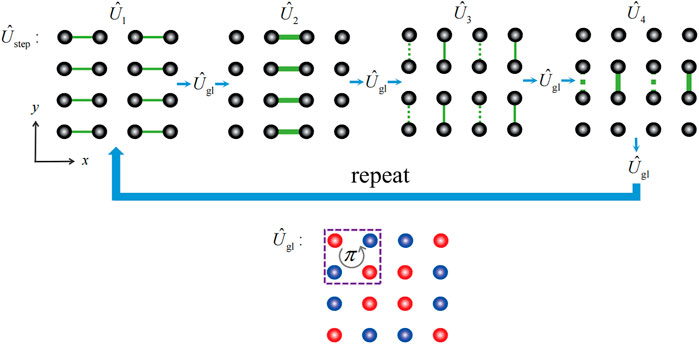
FIGURE 1. Up: Schematic of the eight-step non-unitary coinless DTQW in a two-dimensional lattice. For the four unitary substep operators
Based on recent experimental progress of quantum walks in waveguides [66, 69–73], the realization of Eq. 5 is accessible under the flexible control of the three-dimensional photonic waveguides. Specifically, the above discussed coinless DTQW except the gain-loss term
In order to illustrate the effect of the gain-loss term
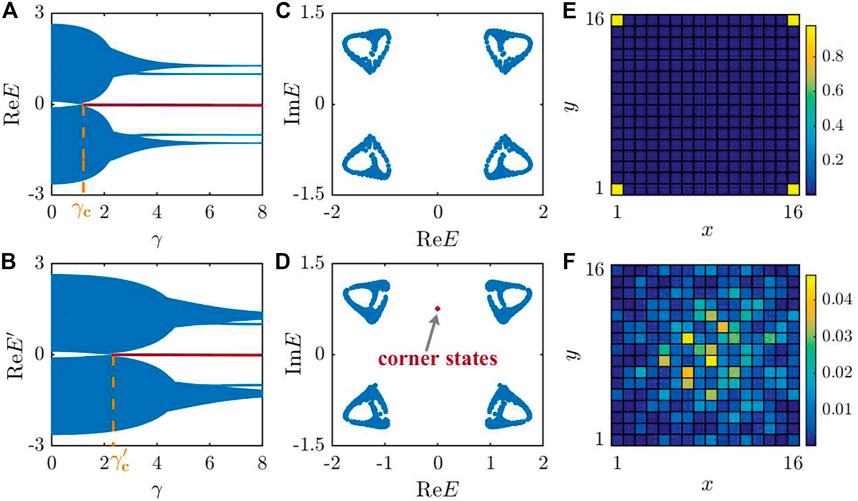
FIGURE 2. (A,B) Real part of the quasi-energy spectrum obtained from the effective Hamiltonian
A unique phenomenon in non-Hermitian systems is the appearance of the skin effects [14], which means that all of the eigenstates will be localized near the boundary under the open boundary conditions. However, the skin effects will not emerge in all of the non-Hermitian systems [16]. A major consequence of non-Hermitian systems with the skin effects is that the bulk bands of the system under the open boundary conditions are considerably different from those of the system under the periodic boundary conditions. Thus, we show the complete quasi-energy spectrum under the open and periodic boundary conditions in Figures 2C,D, respectively. We find that the bulk bands under the different boundary conditions are consistent except the emergence of the four energy-degenerate states at ReE = 0 when we consider the open boundary conditions. Figures 2C,D strongly demonstrate that our system does not suffer from the skin effects and therefore it does not matter whether the right and/or left eigenstates are used to calculate the density distribution. In Figure 2E, we show the collective density distributions of these four energy-degenerate gapless states at ReE = 0, which are localized at the four corners of the lattice. And the remaining two energy-degenerate gapped states at ReE ≠ 0 are indeed extended in the bulk of the lattice, as shown in Figure 2F.
The emergence of the exotic four energy-degenerate corner states at ReE = 0 can be attributed to the second-order bulk topology, which corresponds a kind of topological phase supporting lower-dimensional corner or hinge states, induced by the gain-loss term
The second-order topological invariant of polarizations are constructed in momentum space. Thus, we first need to renumber the lattice sites in terms of the unit cell, each of which contains 16 sublattices, as shown in Figure 3. Using the Fourier transformation, the one-step operator can be written in momentum space as
which satisfies the biorthogonal normalization
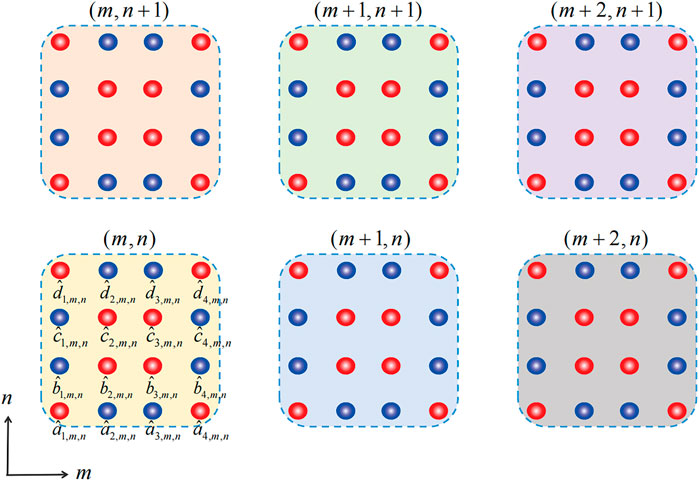
FIGURE 3. The unit cells, labeled with (m, n), of our coinless DTQW in the two-dimensional lattice. Each unit cell has 16 sublattices, which are labeled as
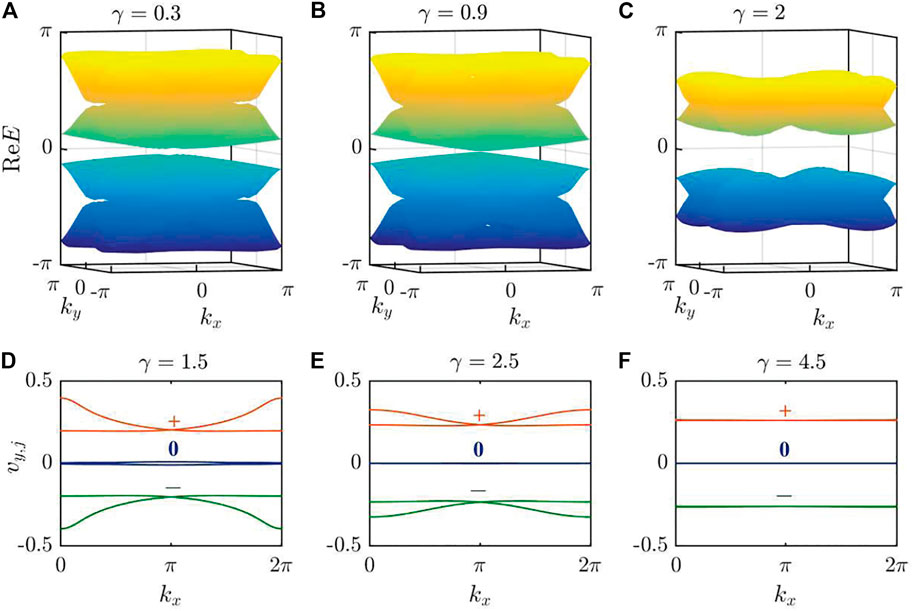
FIGURE 4. (A–C) Real quasi-energy spectrum in momentum space of the effective Hamiltonian
To characterize the gapped phases using polarizations, we consider the case of half filling and define the biorthogonal Wilson loop operator along y direction as
where
where j is the Wannier band index and
where
where ex is the unit vector in the x direction and Δkx = 2π/Nx, the indices l, l′ ∈ 1 … NW with NW the number of the Wanner bands in sector ς. In Eq. 17, summation is implied over repeated indices r, … , s ∈ 1 … NW over all Wannier bands in sector ς. After that, we can obtain the polarizations along x direction as
In a similar way, we can directly obtain the Wannier bands vx,j and polarizations along y direction
Using the above procedure, we numerically calculate the polarizations
The topological invariant W has two possible quantized values: 0 and 1, which corresponds to the trivial and topological phases, respectively. In Figure 5B, we show the topological phase diagram of the topological invariant P versus the coupling parameter J1 and the gain-loss parameter γ. When J1 ∈ (0.5, 1), the system with γ = 0 is in the topological phase and will still remain topological as γ is incremented from zero. However, the system with γ = 0 is in the trivial phase with J1 ∈ (1, 1.5) and will become topological when γ > γc. Furthermore, the value of γc will increase sharply as we increase J1.

FIGURE 5. (A) Polarizations
Experimentally, the exotic corner states can be observed through the localization of probability distributions in multi-step non-unitary coinless DTQWs. Without the existence of the local states, such as the above discussed corner states, the typical transfer behavior of the coinless DTQW is ballistic [63]. In this section, we demonstrate the existence of the corner states by showing the numerical results of probability distributions of multistep non-unitary coinless DTQWs with different gain-loss parameters and initial states. We fix the coupling parameter at J1 = 1.1 and tune the gain-loss parameter γ.
First, we tune the gain-loss parameter at γ = 3.5, which corresponds to a topological phase with the emergence of localized corner states, and initialize the walker at one corner (x, y) = (1, 16) of the lattice. As shown in Figure 6A, since the initial state has a large overlap with the corner state, the most part of the walker’s wave packet remains localized near the same corner as increasing the step of the quantum walk. Then, we tune the gain-loss parameter at γ = 0.5, which corresponds to a trivial phase. Since the absence of the localized corner states, the probability distributions of the walker spread ballistically into the bulk with increasing the step of the quantum walk, see Figure 6B. When the initial states are prepared at other three corners of the lattice, the numerical results are similar and thus are not shown here. Finally, we retune the gain-loss parameter at γ = 3.5 and initial the walker at the bulk (x, y) = (8, 8) of the lattice. Similiar to the second case, the walker’s wave packet extends into the bulk as increasing the step of the quantum walk, which further confirms the absence of the non-Hermitian skin effects with the nonlocalization of the bulk states, see Figure 6C.
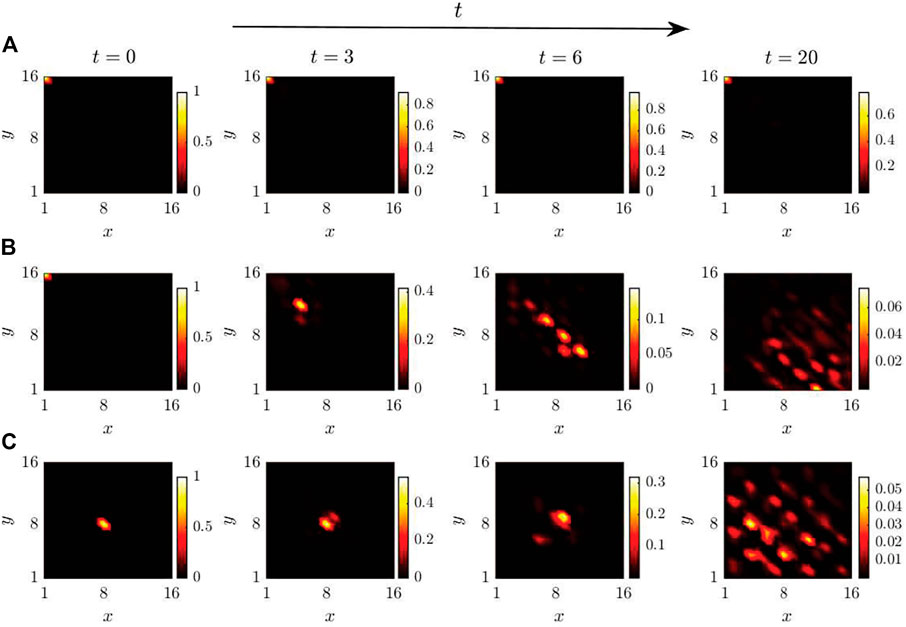
FIGURE 6. Probability distributions
We first give a more detailed illustration of the topological phase diagram. In Section 4, we only show part of the complete topological phase diagram for simplicity. Actually, the complete phase diagram has a period of π in the J1 direction, see Figure 7. Moreover, when the coupling parameter J1 converges to qπ/2 (q is an integer), the value of γc will go to infinity. Especially, when the coupling parameter is exactly fixed at J1 = qπ/2, a 100%-coupling is present for each unitary sub-evolutionary process governed by
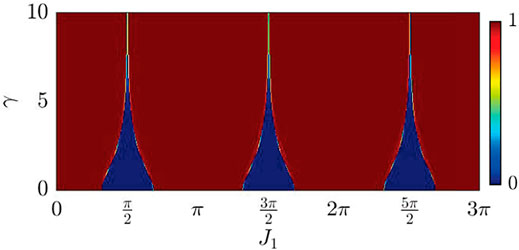
FIGURE 7. Complete topological phase diagram of eight-step non-unitary coinless DTQWs characterized by the topological invariant W versus the coupling parameter J1 and the gain-loss parameter γ.
In summary, we have constructed a two-dimensional non-unitary coinless DTQW which exhibits nontrivial second-order non-Hermitian topology. We have shown second-order non-Hermitian topological phase diagram characterized by polarizations. Finally, we have shown that the corner states can be observed through the probability distributions. Our work suggests that the coinless DTQW is a potential platform to explore novel non-Hermitian higher-order topological quantum phases, and may shed light on the ongoing exploration of topologically protected quantum information processing.
The original contributions presented in the study are included in the article/Supplementary Material, further inquiries can be directed to the corresponding author.
YM: theory and writing.
The author declares that the research was conducted in the absence of any commercial or financial relationships that could be construed as a potential conflict of interest.
All claims expressed in this article are solely those of the authors and do not necessarily represent those of their affiliated organizations or those of the publisher, the editors, and the reviewers. Any product that may be evaluated in this article, or claim that may be made by its manufacturer, is not guaranteed or endorsed by the publisher.
1. Hasan MZ, Kane CL. Colloquium: Topological Insulators. Rev Mod Phys (2010) 82:3045–67. doi:10.1103/revmodphys.82.3045
2. Qi X-L, Zhang S-C. Topological Insulators and Superconductors. Rev Mod Phys (2011) 83:1057–110. doi:10.1103/revmodphys.83.1057
3. Chiu CK, Teo JC, Schnyder AP, Ryu S. Classification of Topological Quantum Matter with Symmetries. Rev Mod Phys (2016) 88:035005. doi:10.1103/revmodphys.88.035005
4. Benalcazar WA, Bernevig BA, Hughes TL. Quantized Electric Multipole Insulators. Science (2017) 357:61–6. doi:10.1126/science.aah6442
5. Benalcazar WA, Bernevig BA, Hughes TL. Electric Multipole Moments, Topological Multipole Moment Pumping, and Chiral Hinge States in Crystalline Insulators. Phys Rev B (2017) 96:245115. doi:10.1103/physrevb.96.245115
6. Serra-Garcia M, Peri V, Süsstrunk R, Bilal OR, Larsen T, Villanueva LG, et al. Observation of a Phononic Quadrupole Topological Insulator. Nature (2018) 555:342–5. doi:10.1038/nature25156
7. Peterson CW, Benalcazar WA, Hughes TL, Bahl G. A Quantized Microwave Quadrupole Insulator with Topologically Protected Corner States. Nature (2018) 555:346–50. doi:10.1038/nature25777
8. Imhof S, Berger C, Bayer F, Brehm J, Molenkamp LW, Kiessling T, et al. Topolectrical-circuit Realization of Topological Corner Modes. Nat Phys (2018) 14:925–9. doi:10.1038/s41567-018-0246-1
9. Su WP, Schrieffer JR, Heeger AJ. Solitons in Polyacetylene. Phys Rev Lett (1979) 42:1698–701. doi:10.1103/physrevlett.42.1698
10. Liu F, Wakabayashi K. Novel Topological Phase with a Zero berry Curvature. Phys Rev Lett (2017) 118:076803. doi:10.1103/PhysRevLett.118.076803
11. Wang YH, Steinberg H, Jarillo-Herrero P, Gedik N. Observation of Floquet-Bloch States on the Surface of a Topological Insulator. Science (2013) 342:453–7. doi:10.1126/science.1239834
12. Rechtsman MC, Zeuner JM, Plotnik Y, Lumer Y, Podolsky D, Dreisow F, et al. Photonic Floquet Topological Insulators. Nature (2013) 496:196–200. doi:10.1038/nature12066
13. Yao S, Yan Z, Wang Z. Topological Invariants of Floquet Systems: General Formulation, Special Properties, and Floquet Topological Defects. Phys Rev B (2017) 96:195303. doi:10.1103/physrevb.96.195303
14. Yao S, Wang Z. Edge States and Topological Invariants of Non-hermitian Systems. Phys Rev Lett (2018) 121:086803. doi:10.1103/PhysRevLett.121.086803
15. Yao S, Song F, Wang Z. Non-hermitian Chern Bands. Phys Rev Lett (2018) 121:136802. doi:10.1103/physrevlett.121.136802
16. Longhi S. Probing Non-hermitian Skin Effect and Non-bloch Phase Transitions. Phys Rev Res (2019) 1:023013. doi:10.1103/physrevresearch.1.023013
17. Ashida Y, Gong Z, Ueda M. Non-hermitian Physics. Adv Phys (2020) 69:249–435. doi:10.1080/00018732.2021.1876991
18. Bergholtz EJ, Budich JC, Kunst FK. Exceptional Topology of Non-hermitian Systems. Rev Mod Phys (2021) 93:015005. doi:10.1103/revmodphys.93.015005
19. Li J, Chu R-L, Jain JK, Shen S-Q. Topological anderson Insulator. Phys Rev Lett (2009) 102:136806. doi:10.1103/physrevlett.102.136806
20. Jiang H, Wang L, Sun Q-f., Xie XC. Numerical Study of the Topological anderson Insulator in Hgte/cdte Quantum wells. Phys Rev B (2009) 80:165316. doi:10.1103/physrevb.80.165316
21. Meier EJ, An FA, Dauphin A, Maffei M, Massignan P, Hughes TL, et al. Observation of the Topological anderson Insulator in Disordered Atomic Wires. Science (2018) 362:929–33. doi:10.1126/science.aat3406
22. Stützer S, Plotnik Y, Lumer Y, Titum P, Lindner NH, Segev M, et al. Photonic Topological anderson Insulators. Nature (2018) 560:461–5. doi:10.1038/s41586-018-0418-2
23. Kitagawa T, Rudner MS, Berg E, Demler E. Exploring Topological Phases with Quantum Walks. Phys Rev A (2010) 82:033429. doi:10.1103/physreva.82.033429
24. Kitagawa T. Topological Phenomena in Quantum Walks: Elementary Introduction to the Physics of Topological Phases. Quan Inf Process (2012) 11:1107–48. doi:10.1007/s11128-012-0425-4
25. Karski M, Förster L, Choi J-M, Steffen A, Alt W, Meschede D, et al. Quantum Walk in Position Space with Single Optically Trapped Atoms. Science (2009) 325:174–7. doi:10.1126/science.1174436
26. Preiss PM, Ma R, Tai ME, Lukin A, Rispoli M, Zupancic P, et al. Strongly Correlated Quantum Walks in Optical Lattices. Science (2015) 347:1229–33. doi:10.1126/science.1260364
27. Schmitz H, Matjeschk R, Schneider C, Glueckert J, Enderlein M, Huber T, et al. Quantum Walk of a Trapped Ion in Phase Space. Phys Rev Lett (2009) 103:090504. doi:10.1103/PhysRevLett.103.090504
28. Zähringer F, Kirchmair G, Gerritsma R, Solano E, Blatt R, Roos CF. Realization of a Quantum Walk with One and Two Trapped Ions. Phys Rev Lett (2010) 104:100503. doi:10.1103/PhysRevLett.104.100503
29. Peruzzo A, Lobino M, Matthews JCF, Matsuda N, Politi A, Poulios K, et al. Quantum Walks of Correlated Photons. Science (2010) 329:1500–3. doi:10.1126/science.1193515
30. Schreiber A, Cassemiro KN, Potocek V, Gábris A, Mosley PJ, Andersson E, et al. Photons Walking the Line: a Quantum Walk with Adjustable coin Operations. Phys Rev Lett (2010) 104:050502. doi:10.1103/PhysRevLett.104.050502
31. Broome MA, Fedrizzi A, Lanyon BP, Kassal I, Aspuru-Guzik A, White AG. Discrete Single-Photon Quantum Walks with Tunable Decoherence. Phys Rev Lett (2010) 104:153602. doi:10.1103/physrevlett.104.153602
32. Schreiber A, Gábris A, Rohde PP, Laiho K, Štefaňák M, Potoček V, et al. A 2d Quantum Walk Simulation of Two-Particle Dynamics. Science (2012) 336:55–8. doi:10.1126/science.1218448
33. Flurin E, Ramasesh VV, Hacohen-Gourgy S, Martin LS, Yao NY, Siddiqi I. Observing Topological Invariants Using Quantum Walks in Superconducting Circuits. Phys Rev X (2017) 7:031023. doi:10.1103/physrevx.7.031023
34. Ryan CA, Laforest M, Boileau JC, Laflamme R. Experimental Implementation of a Discrete-Time Quantum Random Walk on an Nmr Quantum-Information Processor. Phys Rev A (2005) 72:062317. doi:10.1103/physreva.72.062317
35. Asbóth JK. Symmetries, Topological Phases, and Bound States in the One-Dimensional Quantum Walk. Phys Rev B (2012) 86:195414.
36. Asbóth JK, Obuse H. Bulk-boundary Correspondence for Chiral Symmetric Quantum Walks. Phys Rev B (2013) 88:121406.
37. Edge JM, Asboth JK. Localization, Delocalization, and Topological Transitions in Disordered Two-Dimensional Quantum Walks. Phys Rev B (2015) 91:104202. doi:10.1103/physrevb.91.104202
38. Asboth JK, Edge JM. Edge-state-enhanced Transport in a Two-Dimensional Quantum Walk. Phys Rev A (2015) 91:022324. doi:10.1103/physreva.91.022324
39. Ramasesh VV, Flurin E, Rudner M, Siddiqi I, Yao NY. Direct Probe of Topological Invariants Using Bloch Oscillating Quantum Walks. Phys Rev Lett (2017) 118:130501. doi:10.1103/physrevlett.118.130501
40. Sajid M, Asbóth JK, Meschede D, Werner RF, Alberti A. Creating Anomalous Floquet Chern Insulators with Magnetic Quantum Walks. Phys Rev B (2019) 99:214303. doi:10.1103/physrevb.99.214303
41. Kitagawa T, Broome MA, Fedrizzi A, Rudner MS, Berg E, Kassal I, et al. Observation of Topologically Protected Bound States in Photonic Quantum Walks. Nat Commun (2012) 3:882–7. doi:10.1038/ncomms1872
42. Cardano F, Maffei M, Massa F, Piccirillo B, De Lisio C, De Filippis G, et al. Statistical Moments of Quantum-Walk Dynamics Reveal Topological Quantum Transitions. Nat Commun (2016) 7:11439–8. doi:10.1038/ncomms11439
43. Cardano F, D’Errico A, Dauphin A, Maffei M, Piccirillo B, de Lisio C, et al. Detection of Zak Phases and Topological Invariants in a Chiral Quantum Walk of Twisted Photons. Nat Commun (2017) 8:15516–7. doi:10.1038/ncomms15516
44. Barkhofen S, Nitsche T, Elster F, Lorz L, Gábris A, Jex I, et al. Measuring Topological Invariants in Disordered Discrete-Time Quantum Walks. Phys Rev A (2017) 96:033846. doi:10.1103/physreva.96.033846
45. Flurin E, Ramasesh VV, Hacohen-Gourgy S, Martin LS, Yao NY, Siddiqi I. Observing Topological Invariants Using Quantum Walks in Superconducting Circuits. Phys Rev X (2017) 7:031023. doi:10.1103/physrevx.7.031023
46. Xu X-Y, Wang Q-Q, Pan W-W, Sun K, Xu J-S, Chen G, et al. Measuring the Winding Number in a Large-Scale Chiral Quantum Walk. Phys Rev Lett (2018) 120:260501. doi:10.1103/physrevlett.120.260501
47. Wang B, Chen T, Zhang X. Experimental Observation of Topologically Protected Bound States with Vanishing Chern Numbers in a Two-Dimensional Quantum Walk. Phys Rev Lett (2018) 121:100501. doi:10.1103/physrevlett.121.100501
48. Chen C, Ding X, Qin J, He Y, Luo Y-H, Chen M-C, et al. Observation of Topologically Protected Edge States in a Photonic Two-Dimensional Quantum Walk. Phys Rev Lett (2018) 121:100502. doi:10.1103/physrevlett.121.100502
49. Chalabi H, Barik S, Mittal S, Murphy TE, Hafezi M, Waks E. Synthetic Gauge Field for Two-Dimensional Time-Multiplexed Quantum Random Walks. Phys Rev Lett (2019) 123:150503. doi:10.1103/physrevlett.123.150503
50. Rakovszky T, Asbóth JK, Alberti A. Detecting Topological Invariants in Chiral Symmetric Insulators via Losses. Phys Rev B (2017) 95:201407. doi:10.1103/physrevb.95.201407
51. Xiao L, Zhan X, Bian ZH, Wang KK, Zhang X, Wang XP, et al. Observation of Topological Edge States in Parity-Time-Symmetric Quantum Walks. Nat Phys (2017) 13:1117–23. doi:10.1038/nphys4204
52. Zhan X, Xiao L, Bian Z, Wang K, Qiu X, Sanders BC, et al. Detecting Topological Invariants in Nonunitary Discrete-Time Quantum Walks. Phys Rev Lett (2017) 119:130501. doi:10.1103/physrevlett.119.130501
53. Xiao L, Qiu X, Wang K, Bian Z, Zhan X, Obuse H, et al. Higher Winding Number in a Nonunitary Photonic Quantum Walk. Phys Rev A (2018) 98:063847. doi:10.1103/physreva.98.063847
54. Wang K, Qiu X, Xiao L, Zhan X, Bian Z, Sanders BC, et al. Observation of Emergent Momentum-Time Skyrmions in Parity-Time-Symmetric Non-unitary Quench Dynamics. Nat Commun (2019) 10:2293–8. doi:10.1038/s41467-019-10252-7
55. Wang K, Qiu X, Xiao L, Zhan X, Bian Z, Yi W, et al. Simulating Dynamic Quantum Phase Transitions in Photonic Quantum Walks. Phys Rev Lett (2019) 122:020501. doi:10.1103/PhysRevLett.122.020501
56. Xiao L, Wang K, Zhan X, Bian Z, Kawabata K, Ueda M, et al. Observation of Critical Phenomena in Parity-Time-Symmetric Quantum Dynamics. Phys Rev Lett (2019) 123:230401. doi:10.1103/physrevlett.123.230401
57. Longhi S. Non-Bloch ${\cal P}{\cal T}$PT Symmetry Breaking in Non-hermitian Photonic Quantum Walks. Opt Lett (2019) 44:5804–7. doi:10.1364/OL.44.005804
58. Xiao L, Deng T, Wang K, Zhu G, Wang Z, Yi W, et al. Non-Hermitian Bulk-Boundary Correspondence in Quantum Dynamics. Nat Phys (2020) 16:761–6. doi:10.1038/s41567-020-0836-6
59. Xiao L, Deng T, Wang K, Wang Z, Yi W, Xue P. Observation of Non-bloch Parity-Time Symmetry and Exceptional Points. Phys Rev Lett (2021) 126:230402. doi:10.1103/physrevlett.126.230402
60. Meng Y, Chen G, Jia S. Second-order Topological Insulator in a Coinless Discrete-Time Quantum Walk. Phys Rev A (2020) 102:012203. doi:10.1103/physreva.102.012203
61. Aharonov Y, Davidovich L, Zagury N. Quantum Random Walks. Phys Rev A (1993) 48:1687–90. doi:10.1103/physreva.48.1687
62. Patel A, Raghunathan K, Rungta P. Quantum Random Walks Do Not Need a coin Toss. Phys Rev A (2005) 71:032347. doi:10.1103/physreva.71.032347
63. Portugal R, Boettcher S, Falkner S. One-dimensional Coinless Quantum Walks. Phys Rev A (2015) 91:052319. doi:10.1103/physreva.91.052319
64. Khatibi Moqadam J, de Oliveira MC, Portugal R. Staggered Quantum Walks with Superconducting Microwave Resonators. Phys Rev B (2017) 95:144506. doi:10.1103/physrevb.95.144506
65. Moqadam JK, Rezakhani AT. Boundary-induced Coherence in the Staggered Quantum Walk on Different Topologies. Phys Rev A (2018) 98:012123. doi:10.1103/physreva.98.012123
66. Maczewsky LJ, Zeuner JM, Nolte S, Szameit A. Observation of Photonic Anomalous Floquet Topological Insulators. Nat Commun (2017) 8:13756–7. doi:10.1038/ncomms13756
67. Takata K, Notomi M. Photonic Topological Insulating Phase Induced Solely by Gain and Loss. Phys Rev Lett (2018) 121:213902. doi:10.1103/physrevlett.121.213902
68. Liu S, Ma S, Yang C, Zhang L, Gao W, Xiang YJ, et al. Gain-and Loss-Induced Topological Insulating Phase in a Non-hermitian Electrical Circuit. Phys Rev Appl (2020) 13:014047. doi:10.1103/physrevapplied.13.014047
69. Sansoni L, Sciarrino F, Vallone G, Mataloni P, Crespi A, Ramponi R, et al. Two-particle Bosonic-Fermionic Quantum Walk via Integrated Photonics. Phys Rev Lett (2012) 108:010502. doi:10.1103/PhysRevLett.108.010502
70. Crespi A, Osellame R, Ramponi R, Giovannetti V, Fazio R, Sansoni L, et al. Anderson Localization of Entangled Photons in an Integrated Quantum Walk. Nat Photon (2013) 7:322–8. doi:10.1038/nphoton.2013.26
71. Tang H, Lin XF, Feng Z, Chen JY, Gao J, Sun K, et al. Experimental Two-Dimensional Quantum Walk on a Photonic Chip. Sci Adv (2018) 4:eaat3174. doi:10.1126/sciadv.aat3174
72. Tang H, Di Franco C, Shi Z-Y, He T-S, Feng Z, Gao J, et al. Experimental Quantum Fast Hitting on Hexagonal Graphs. Nat Photon (2018) 12:754–8. doi:10.1038/s41566-018-0282-5
73. El Hassan A, Kunst FK, Moritz A, Andler G, Bergholtz EJ, Bourennane M. Corner States of Light in Photonic Waveguides. Nat Photon (2019) 13:697–700. doi:10.1038/s41566-019-0519-y
74. Boada O, Novo L, Sciarrino F, Omar Y. Quantum Walks in Synthetic Gauge fields with Three-Dimensional Integrated Photonics. Phys Rev A (2017) 95:013830. doi:10.1103/physreva.95.013830
75. El-Ganainy R, Makris KG, Khajavikhan M, Musslimani ZH, Rotter S, Christodoulides DN. Non-hermitian Physics and Pt Symmetry. Nat Phys (2018) 14:11–9. doi:10.1038/nphys4323
76. Luo XW, Zhang C. Higher-order Topological Corner States Induced by Gain and Loss. Phys Rev Lett (2019) 123:073601. doi:10.1103/PhysRevLett.123.073601
77. Ezawa M. Non-hermitian Higher-Order Topological States in Nonreciprocal and Reciprocal Systems with Their Electric-Circuit Realization. Phys Rev B (2019) 99:201411. doi:10.1103/physrevb.99.201411
78. Ezawa M. Non-hermitian Boundary and Interface States in Nonreciprocal Higher-Order Topological Metals and Electrical Circuits. Phys Rev B (2019) 99:121411. doi:10.1103/physrevb.99.121411
79. Okugawa R, Takahashi R, Yokomizo K. Second-order Topological Non-hermitian Skin Effects. Phys Rev B (2020) 102:241202. doi:10.1103/physrevb.102.241202
80. Kawabata K, Sato M, Shiozaki K. Higher-order Non-hermitian Skin Effect. Phys Rev B (2020) 102:205118. doi:10.1103/physrevb.102.205118
81. Liu T, Zhang YR, Ai Q, Gong Z, Kawabata K, Ueda M, et al. Second-order Topological Phases in Non-hermitian Systems. Phys Rev Lett (2019) 122:076801. doi:10.1103/PhysRevLett.122.076801
82. Rodriguez-Vega M, Kumar A, Seradjeh B. Higher-order Floquet Topological Phases with Corner and Bulk Bound States. Phys Rev B (2019) 100:085138. doi:10.1103/physrevb.100.085138
83. Bomantara RW, Zhou L, Pan J, Gong J. Coupled-wire Construction of Static and Floquet Second-Order Topological Insulators. Phys Rev B (2019) 99:045441. doi:10.1103/physrevb.99.045441
84. Seshadri R, Dutta A, Sen D. Generating a Second-Order Topological Insulator with Multiple Corner States by Periodic Driving. Phys Rev B (2019) 100:115403. doi:10.1103/physrevb.100.115403
85. Peng Y, Refael G. Floquet Second-Order Topological Insulators from Nonsymmorphic Space-Time Symmetries. Phys Rev Lett (2019) 123:016806. doi:10.1103/PhysRevLett.123.016806
86. Hu H, Huang B, Zhao E, Liu WV. Dynamical Singularities of Floquet Higher-Order Topological Insulators. Phys Rev Lett (2020) 124:057001. doi:10.1103/PhysRevLett.124.057001
Keywords: coinless discrete-time quantum walks, non-Hermitian, higher-order topology, corner states, photonic waveguides
Citation: Meng Y (2022) Topological Corner States in Non-Unitary Coinless Discrete-Time Quantum Walks. Front. Phys. 10:861125. doi: 10.3389/fphy.2022.861125
Received: 24 January 2022; Accepted: 31 March 2022;
Published: 03 May 2022.
Edited by:
Dong-Hui Xu, Chongqing University, ChinaReviewed by:
Jianming Wen, Kennesaw State University, United StatesCopyright © 2022 Meng. This is an open-access article distributed under the terms of the Creative Commons Attribution License (CC BY). The use, distribution or reproduction in other forums is permitted, provided the original author(s) and the copyright owner(s) are credited and that the original publication in this journal is cited, in accordance with accepted academic practice. No use, distribution or reproduction is permitted which does not comply with these terms.
*Correspondence: Ya Meng, bWVuZ3lhNDE4QDE2My5jb20=
Disclaimer: All claims expressed in this article are solely those of the authors and do not necessarily represent those of their affiliated organizations, or those of the publisher, the editors and the reviewers. Any product that may be evaluated in this article or claim that may be made by its manufacturer is not guaranteed or endorsed by the publisher.
Research integrity at Frontiers

Learn more about the work of our research integrity team to safeguard the quality of each article we publish.